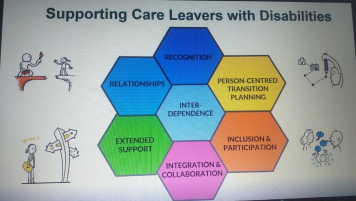Miracle Foundation India participated in an informative & much important session of “Helping children with disabilities to Thrive” by Christian Alliance for Orphans (CAFO). The symposium explored how to help children with disabilities thrive. The event shared practical tips and insight from the top researchers in the field. We are delighted to share our knowledge, understanding and highlights from the sessions. As it is something that we believe everyone should know about.
Children with disabilities are left behind when it comes to placements in their families. Large number of the disabled children are in out of home placements i.e., in the institutions, care facilities and are often in the last to be moved to the families. Also, there are less interventions and efforts for these children’s placements with their families in comparison to other children. Disability and trauma are very much interlinked. If we want to care and support the children who are separated from their families, we need to be competent enough to serve these children and their families.
Even after providing a technical solution to the problem disabled people were not able to use the water from the well as others were using. After a long conversation with the community, they understood that the cultural belief of the community about the people with disability is the main reason and which was blocking their physical access to the water. Thereafter, the organization used this opportunity to create awareness on the disabilities in the community.
There are 5 stages to work with children with disabilities
- Ignorance: the community is unaware of people with disabilities and their absence is unnoticed.
- Evaluation: communities are interested in helping and including people with disabilities but not sure how to start.
- Care: People with disabilities are not just recipients of care, but genuine peer relationships have developed.
- Friendship with people with disabilities, more than professional relationships as many of these people do not have close friends.
- Contribution: people with disabilities are contributing as equals, leading in their sphere of influence and so on.
Session 1: Guidelines for writing about people with disabilities
- Ask to find out if an individual is willing to disclose their disability.
- Ask to find out an individual;s language preferences- Some people see their disability as an essential part of who they are and prefer Identity First Language (i.e. deaf person). Others prefer Person- First Language (i.e. person who is deaf).
- In general, refer to the person first and the disability second.- When in doubt, use Person First Language, which acknowledges that a person is not a disability. or diagnosis; a person has a disability, condition, or diagnosis.
- Emphasize abilities, not limitations. Empower individuals by emphasizing what people can do instead of what they can not.
- Use neutral language - never condescending euphemisms or offensive words. Words such as “victim” and “invalid” portray the person as passive or suggest a lack of something, neither of which are true. Though words like “differently abled”, “challenged”, “handi-capable” or “special” are sometimes accepted, they are often considered condescending and should not be used.
First video reflection documents:
1. Katie's disability Awareness Video. (Youtube video give us some tips about how to communication and interact with the differently abled person)
2. Jino and Friends ministry podcast
Click here to read the podcast
Session 2: Play and Children with Disabilities
Session by Karen Doyle, a registered play therapist 
In this session, the facilitator shared the importance of play to support children thrive.
The stages of the Play:
- Unoccupied Play
- Solidarity play
- Onlooker Play
- Parallel Play
- Cooperative Play
- Associative play
It is important to note that the timing of each child’s progression through the stages - particularly for those with disabilities - can vary greatly from child to child. These stages serve as a measuring stick to assess growth, not to discourage, keeping in mind that each child has different abilities and needs with distinct interests and preferences.
Key practices and Principle of Play:
- Manage your expectations: Instead of worrying about how you think the child should be playing or what you expect them to do with a certain toy or in a specific situation, let the child decide. When children have control of a situation, they learn to listen to their own cues and promptings, making learning developmentally appropriate for them, while also fun and engaging.
- Set the Scene: Create opportunities and give the child freedom to explore likes and dislikes. We live in a world full of variety and wonder; share it with the child and allow discovery.
- Support and Guide: Just like parents support a child learning to walk by providing a steady hand when needed, being present and engaged in the child’s play gives you the opportunity to support them when they need it. The child might need help learning a new skill, emotional support exploring a new environment, or new ideas and inspiration from their favorite adult. As the child grows and develops, your support can help them reach new heights.
Session 3: Helping Caregivers Love Well
Daren Jones Daren Jones discussed how a child expresses a need and then has that need met. Dr. Aguayo talks about how chronic stress and trauma impact the brain
Reframing and Rethinking Powerful Behaviors
- What is the Need that is driving behavior
- What is my child trying to communicate with me?
- What is my response?
Attachment and Self-Regulation (Attachment Cycle)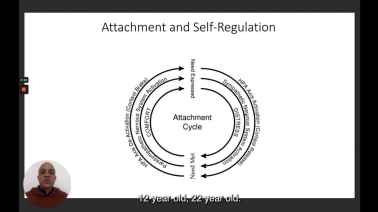
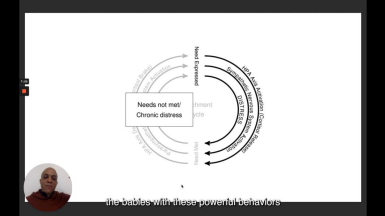
- In the optimum attachment cycle, needs are expressed and needs are then met.
- Healthy attachments help develop the ability of the child to self-regulate their emotions and behaviors.
- If needs are not met, it can lead to chronic distress.
Summary:
- Stay calm no matter what.
- See the need behind the behavior.
- Meet the need, find the why.
Successful interventions to disarm children:
- Find alternative ways to connect and discipline the child.
- The child is worried about the next to 5-10 minutes.
- Stop fighting and start playing in a way that encourages learning.
- Children want to please. If they are not acting like they want to please, it is because they think they can’t please you. Delight in the child.
- Connection and play can change the way a family and organization function.
Session 4: Possibilities: Helping Children Thrive as They Move into Adulthood
Challenges or Concerns during the Transition of adulthood:
- Belonging with the social life
- Misconceptions and myths of the community- they refrain from association
- Judgmental for the strength of the differently abled
- Discrimination - socially and emotionally as well as economically too.
What helps to succeed to the differently abled
- faithfulness in ourselves- self awareness of our strengths.
- Acceptance of the disability
Advice to the different abled during transition:
- Ability to learn how to learn properly in high schools before entering college.
- Learning how to be professional and punctual.
- Balance in social life, education and work.
- Peer support to learn their experience and apply positive things
- know do’s and don’ts for success
- fearless to speak about yourself and your need
- take initiatives and Advocacy for ourselves and ask for the help
- Choose our community for support
- To be able to know “ who I am “ knows about strengths and weaknesses.
Presentation on Model to conceptualize the process of transition to adulthood: supporting young people with intellectual disability moving to adulthood:
(by Maria Pallesera (researcher & Professor)- University of Girona ( catalonia Spain)
Factors affecting the transition process are:
- How can we help young people with intellectual disability
- Education
- Employment
- Social inclusion
- Group to help
- Housing facility
- Steps to help person with disability to transit to adulthood
- A person with a disability is the core of the process: creating space to listen to them, find out their dreams, wishes for the future,their concerns, goals, and need of extra support.
- Coordinations with stakeholders to build strong path of transition: involve professionals, families, other agents in the community,
- Social networks: friends, relatives and other people
- Plan a transition
Supporting care leavers with disability (presentation by Berni Kelly: professor - Quinse University, Northern Ireland.)
Presentation on: Child welfare Reform: Youth transitioning to Adulthood in era of COVID 19:
( By Dr.Johanna Greeson: Director of Field centre- social policy and practice- University of Pennsylvania)
A. General recommendations to provide safety, Health and wellbeing during COVID 19.
- Ensure that older youth in foster care stay safe , Hosed and sated.
- Provide emotional support and reliable information to youth in foster care and young adults who have recently exited care.
- Facilitate access to assistance programs and distribute concrete resources directly to the youth
B. Recommendations to improve child welfare practices in consideration of COVID 19.
- Promote and support emotional / relational permanency
- increase the frequency of virtual visitation
- Ensure access to technology for older youth in foster care
- Allow for flexibility in increasing foster parents Per Diem stipends.
- Create an emergency response plan
CAFO invited to participate to be part of some exciting new research they are undertaking to highlight the strength of adults, who had care experiences with children. Currently, they have more than 50 nations represented. any adult from us who experienced care as a child through adoption, kinship care, residential care or foster care, if not, please share with those you know, who qualify.CAFO wants to learn from these folks about what made a positive difference in their lives, so CAFO can do more of that for future children.
Session 5: Transforming Care for Children with Disabilities
- Family Support for the Children with disabilities( By Delia Pop)
A. What is the ecological model and what are the avenues we have to provide support to children with disabilities and their families.
Ecological Model
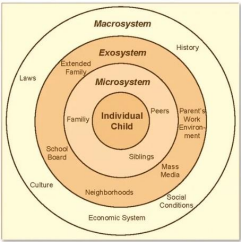
B. Six key strategies to help children with disabilities thrive.
- Understanding Context-protective and risk factors.
- Parenting Support-Information, Knowledge, Skills and competencies.
- Family strengthening- improve family functioning and grounding child rearing into a system of supportive relationships.
- Community level support- access to community resources, informal and formal support to actively participate in community life.
- Access to universal services- Social protection, health, education and Employment.
- Access to specialist services- including respite care.
C. Success factors for working with Children with disabilities.
- Partnership with families
- Building agencies and Empowering families.
- Strengthening protective factors.
- Reducing and mitigating risks.
- Focused on self efficacy and utilising home made solutions.
- Graduation model.
D. Family based alternative care ( For children without parental care)
- Kinship Care
- Foster Care
- Long term foster care
- Special Guardianship
- Supported community based living
- Supported employment
2. Integration of disabilities in care reforms ( By Beth- Bradford, Technical director, Change the way we care).
- Over 3 million (1 out of 7) people experience disability.
- 90 million children with disabilities are in the world.
- 5% of all the children and not all disabilities are visible.
- There is a strong link between disability and poverty. Disability is both the cause and consequences of poverty.
- What are the ways people understand disability?
- Limited activity
- Restricted Participation
- Impairment
- Disability
- Definition of Disability according to UN convention on the rights of the children with disabilities- 'Persons with disabilities include those who have long-term physical, mental, intellectual or sensory impairments which in interaction with various barriers may hinder their full and effective participation in society on an equal basis with others'.
- Different Models addressing disability-
- Charity model: “Feeling sorry”, “We will do something for you”
- Human rights model: This is a human rights issue.
- Medical model: There must be something wrong. Let’s treat the problem. • Social model: Something is wrong with society. We need to change society to be more inclusive.
- For inclusion of children with disabilities- We do
- Non discrimination
- Full and meaningful participation
- Accessibility and Accommodation
- Universal design
Session 6: Innovations and Applications
- Transition process of differently abled children should get equal p
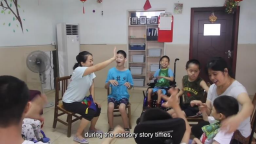 riority like other children.
riority like other children. - Resource mapping in terms of schemes, programs, models and best practices need to be understood in relation to the practicability.
- Look out for community based rehabilitation models which can leverage convergence of resources so institutional care can be minimised.
- There needs to be a great deal of sensitization and guidance that has to go for caregivers and at community level. Care economy to be boosted and made visible. Provisions for incentives, training should be in the basket of offerings.
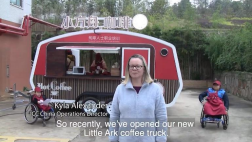
- Differently abled children to be encouraged to use more assistive devices for self dependence.
- Use of assistive technology to be introduced and promotion of disabled friendly infrastructure tobe done.
Additional Live Sessions
- Supporting Children and Families:
- Delia Pop has presented about the key Strategies to help children with disabilities thrive is the same thing which we cover in our DCPU training curriculum.
- The Ecological model framework was fantastic to understand the avenues of support to children with disability. it was well said about “the centre of our support planning for individual need, circumstances and surrounding by micro system formed by family members, peers, siblings, surrounded by the exosystem formed by extended family members, schools, neighbourhood , the parents work environment, media and ultimately placed in a macro system formed by the laws, culture, economic system,social conditions and history. She recommends utilising this for proper support.

